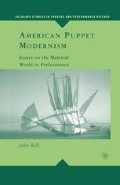Abstract
Ellen Van Volkenburg’s embrace of puppetry as an art form had effects both direct and indirect on American theatre in the first three decades of the twentieth century. An important part of this is the delicate symbiotic relationship between art theatre as a not-for-profit (and often distinctly unprofitable) enterprise focused on larger and indistinct cultural and social goals, and commercial theatre as a public, profitmaking venture which serves communities by providing familiar and affirming entertainment. The Manhattan-based puppeteer Tony Sarg, the most successful of the early-twentieth-century puppeteers, was definitely of the latter camp. When Helen Haiman Joseph asked Sarg “why he does not attempt poetic drama with his marionettes” she already knew part of the answer. “He is faced, of course,” she wrote, “with the problem which confronts all the puppet showmen here in America of finding material suitable for a given type of doll and also acceptable to local audiences, hitherto unacquainted with the characteristics and traditions” of the puppet theatre.1 But in his response to Joseph, Sarg sidestepped her question by citing the “exaggerated walk of the dolls, which always brings laughter from the audience” as the main reason he didn’t perform Maeterlinck plays. But the real reason had to be that Jack and the Beanstalk, Rip Van Winkle, Treasure Island, Alice in Wonderland, and other popular tales in Sarg’s repertoire were far more able to meet the expectations of a wider audience than Maeterlinck’s obscure symbolist tragedy The Death of Tintagiles or a poetic drama by Yeats.
Access this chapter
Tax calculation will be finalised at checkout
Purchases are for personal use only
Preview
Unable to display preview. Download preview PDF.
Notes
Helen Haiman Joseph, A Book of Marionettes (New York: B. W Huebsch, 1920) 190.
Ann Douglas, Terrible Honesty Mongrel Manhattan in the 1920s (New York: Noonday, 1995) back cover, 4.
Ralph Chessé, The Marionette Actor (Fairfax, VA: George Mason University Press, 1987) 7.
See Robert Károly Sarlós, Jig Cook and the Provincetown Players: Theater in Ferment (Amherst: University of Massachusetts Press, 1982)
Brenda Murphy, The Provincetown Players and the Culture of Modernity (Cambridge: Cambridge University Press, 2005).
Quoted in Susan Harris Smith, Masks in Modern Drama (Berkeley: University of California Press, 1984) 132.
Aline Fruhauf, Making Faces: Memoirs of a Caricaturist (Santa Barbara, CA: John Daniel and Company, 1990) 83.
David Metzer, “The League of Composers: The Initial Years,” American Music 15.1 (Spring 1997): 46.
For a fuller exploration of such developments, see John Bell, Mechanical Ballets: The Rediscovery of Performing Objects on European Stages from the 1890s to the 1930s (PhD diss., Columbia University, 1993).
Daniel Blum, A Pictorial History of the American Theater (New York: Chilton, 1960) 223.
Michael Gold, quoted in George A. Knox and Herbert M. Stahl, Dos Passos and “The Revolting Playwrights” (Uppsala, Sweden: Lundequistska Bokhandeln, 1964) 8–9.
Shari Benstock, Women of the Left Bank: Paris, 1900–1940 (Austin: University of Texas Press, 1986) 363.
Quoted in Susan Noyes Platt, “Mysticism in the Machine Age: Jane Heap and The Little Review” Twenty/One 1 (Fall 1989): 28.
Sheldon Cheney, “The International Theater Exhibition,” Theater Arts Monthly 10.3 (March 1926): 203.
Quoted in Frederick J. Hunter, “Norman Bel Geddes’ Conception of Dante’s ‘Divine Comedy’” Educational Theatre Journal 18.3 (October 1966): 238.
Copyright information
© 2008 John Bell
About this chapter
Cite this chapter
Bell, J. (2008). New York Puppet Modernism: Remo Bufano and Jane Heap. In: American Puppet Modernism. Palgrave Studies in Theatre and Performance History. Palgrave Macmillan, New York. https://doi.org/10.1057/9780230613768_5
Download citation
DOI: https://doi.org/10.1057/9780230613768_5
Publisher Name: Palgrave Macmillan, New York
Print ISBN: 978-1-137-28670-3
Online ISBN: 978-0-230-61376-8
eBook Packages: Palgrave History CollectionHistory (R0)

